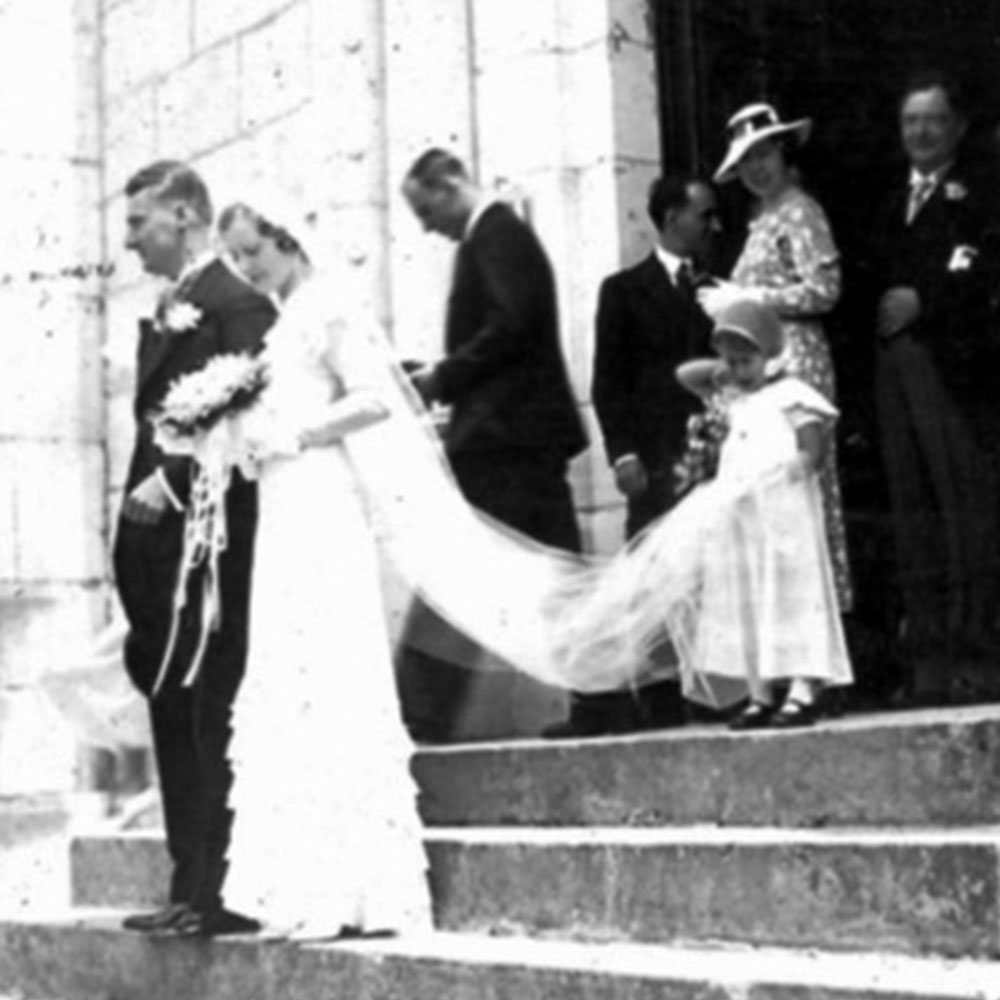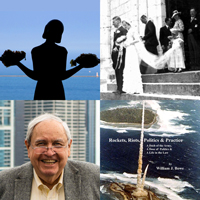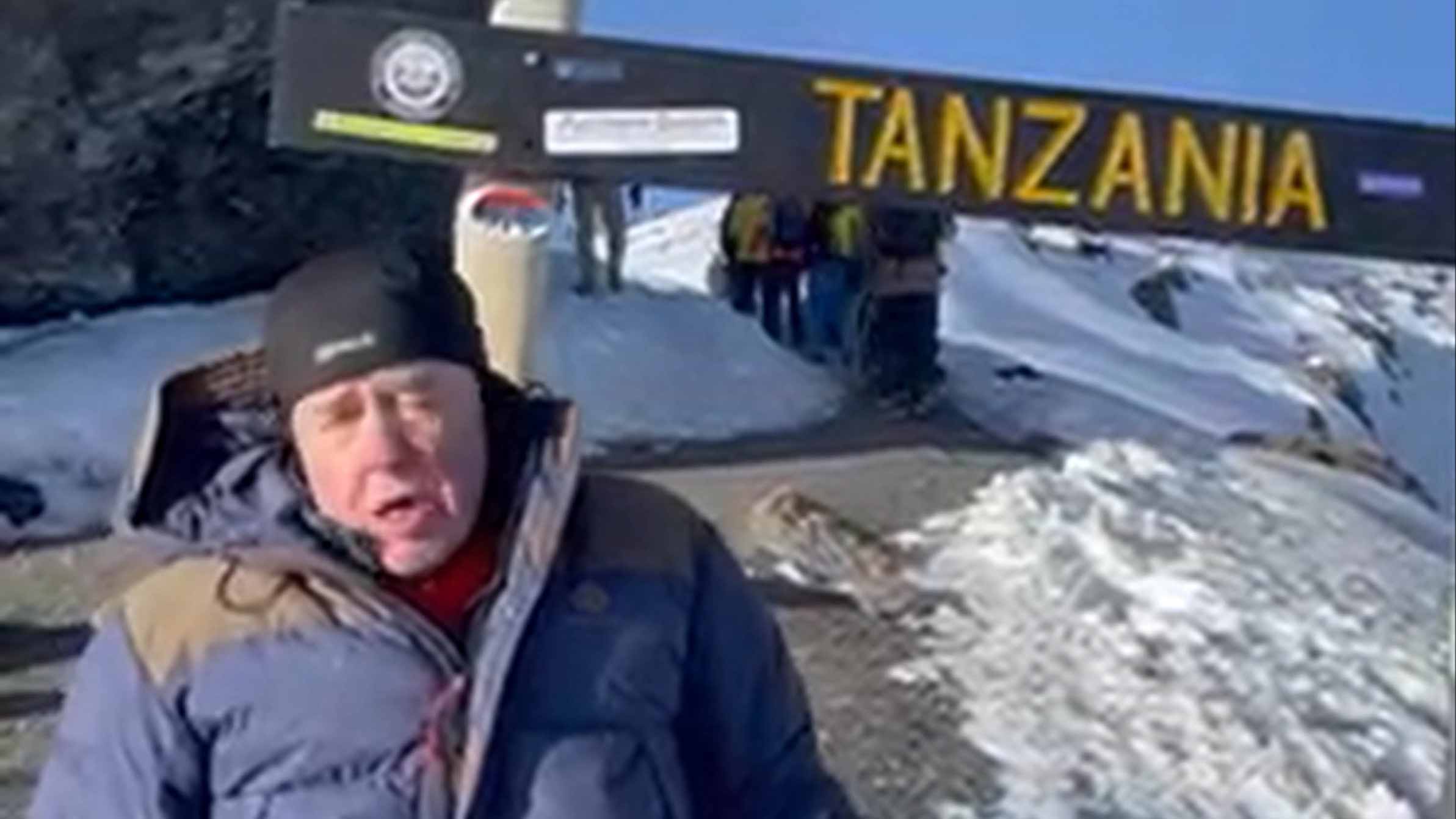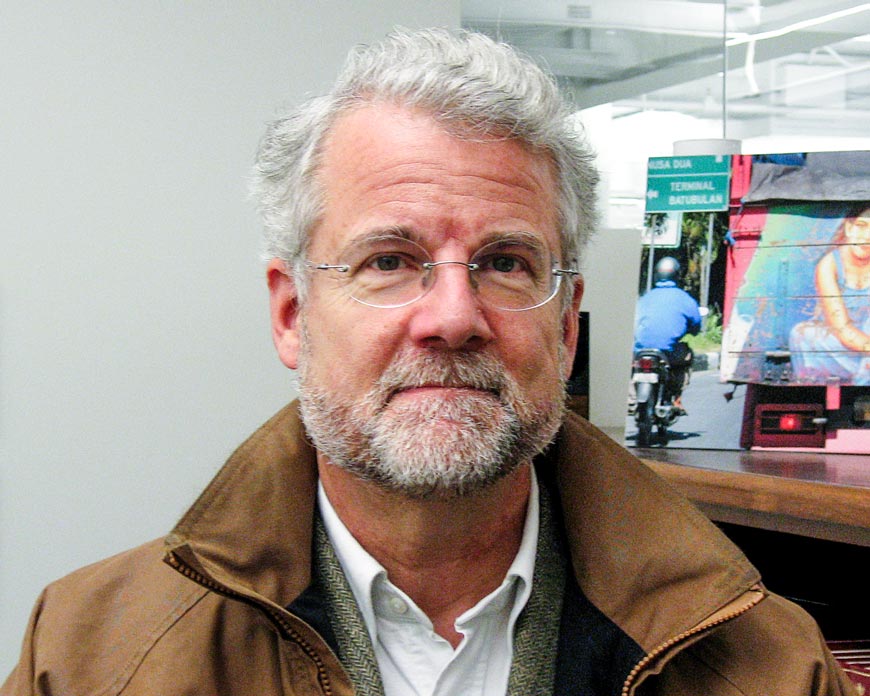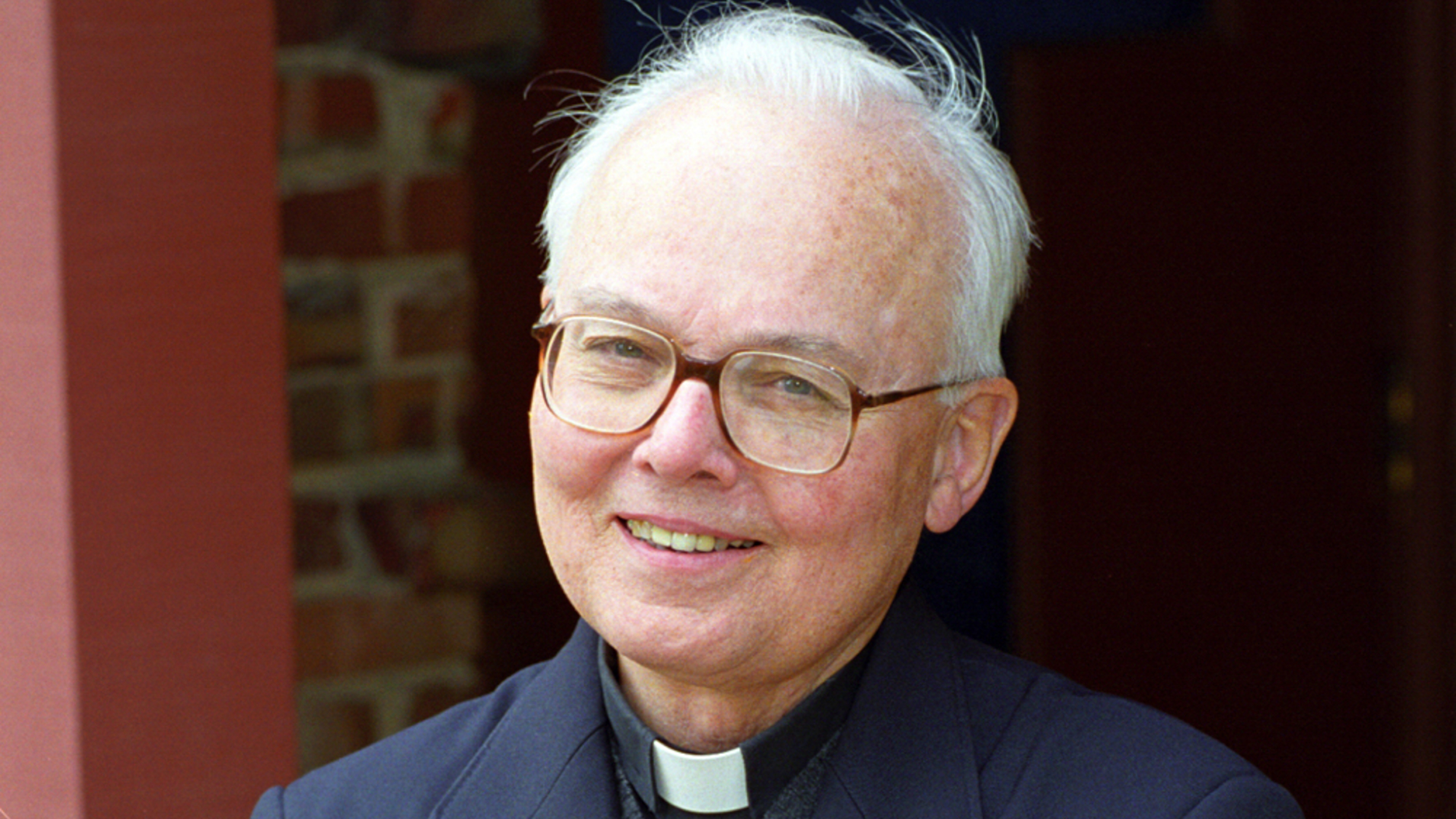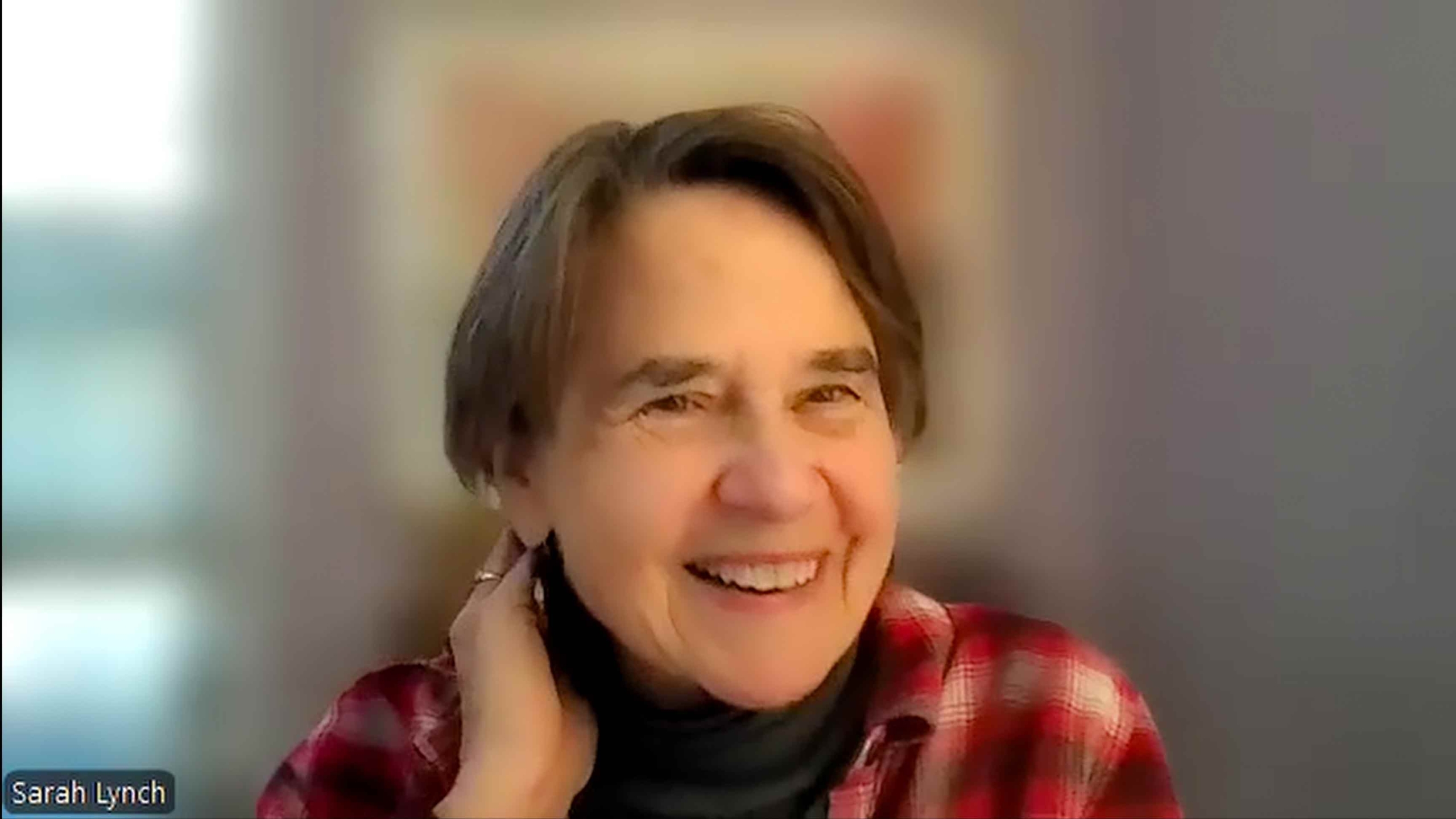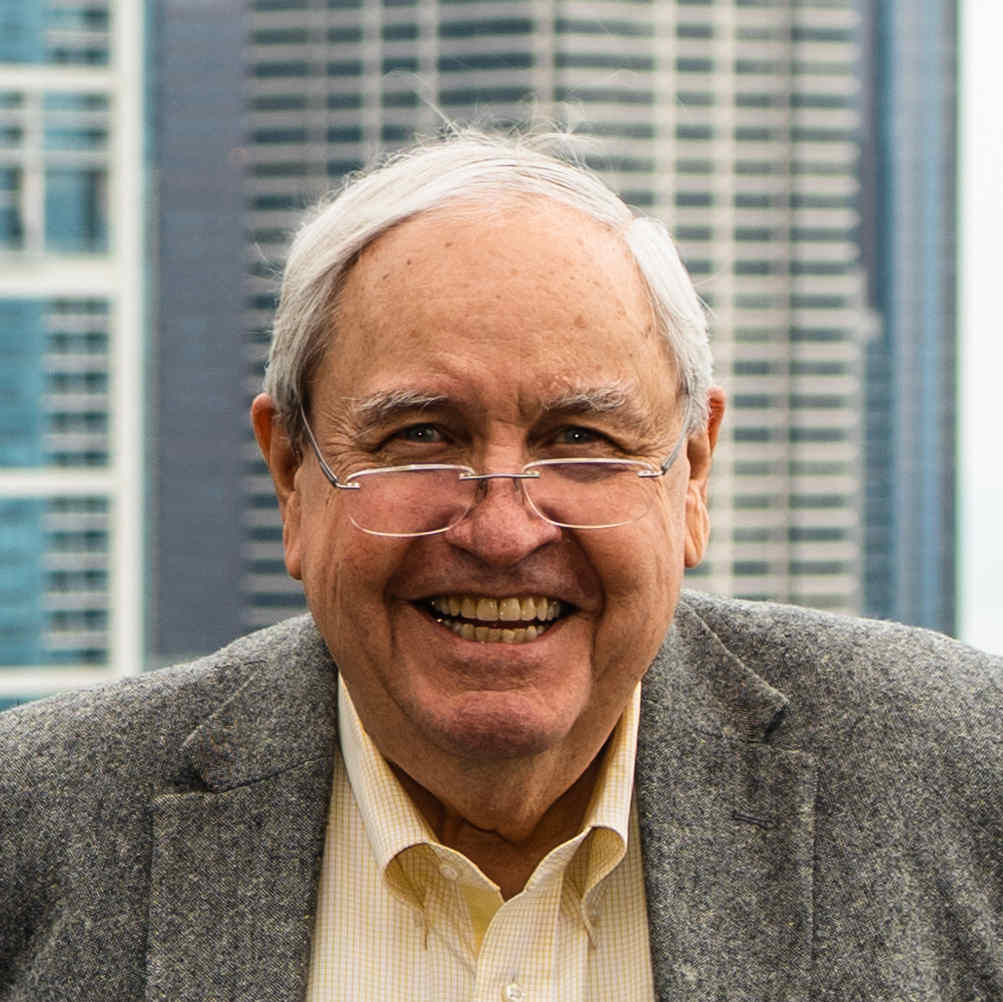Daniel Lynch and Adm. Hyman Rickover
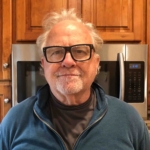 Editor’s Note: My cousin Dan Lynch spent a career in the submarine force as an ETC/SS ANAV (Electronics Technician Chief Petty Officer/Submarine Qualified, Assistant Navigation/Operations Officer) and now enjoys writing short stories about his experiences. Retired these days, he recently sent me a picture of himself reading my book Riots & Rockets, which records something of my own military service. Below is his narrative of the USS San Francisco, SSN 711, beginning in August, 1980. The boat was a Los Angeles Class Attack Submarine on its first shakedown cruise known as “Alpha Trials”.
Editor’s Note: My cousin Dan Lynch spent a career in the submarine force as an ETC/SS ANAV (Electronics Technician Chief Petty Officer/Submarine Qualified, Assistant Navigation/Operations Officer) and now enjoys writing short stories about his experiences. Retired these days, he recently sent me a picture of himself reading my book Riots & Rockets, which records something of my own military service. Below is his narrative of the USS San Francisco, SSN 711, beginning in August, 1980. The boat was a Los Angeles Class Attack Submarine on its first shakedown cruise known as “Alpha Trials”.
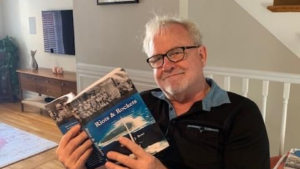
Daniel Lynch reading Riots & Rockets
His remembrance of the sea trials is notable among other things for the presence of Adm. Hyman Rickover. Rickover, the “Father of the Nuclear Navy” with an astounding 63 years of military service, is shown to be a uniquely unusual figure. You can read below Dan’s “My Chance Encounter with God.” Dan’s later 1999 story “The Stowaway, “recalls when he was attached to The Naval Ordnance Test Unit at Port Canaveral, Florida. In his story “My King Midas Moment,” Dan recalls visiting after a long absence the Groton, Connecticut naval base where he started his career as a submariner.
My Chance Encounter with “God”
by Daniel Lynch, US Navy SS (Ret.)
March 18, 2025
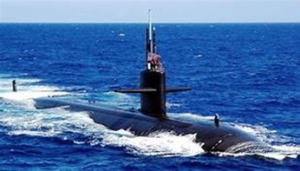 I received orders to report to the USS San Francisco SSN 711 in August 1980.
I received orders to report to the USS San Francisco SSN 711 in August 1980.
These orders had me going to a ‘PreComUnit’ or duty on a ship under
construction. My new ship was being built at the Newport News Shipbuilding and Drydock Company in Hampton Roads Virginia, and it
was going to be the 23rd ship in its class. The lucky 711 was a “Los
Angeles Class” or “688 Class Submarine.” Los Angeles was the name of
the first in the class and 688 was the hull number. However, it was the first ship
in “Flight 2” design, which meant it was coming with a host of major
upgrades and alterations learned from the older ships in the same class. The “fast attack” submarine’s main mission is to locate enemy submarines as part of a rapidly mobilizing battle group. Once the ship completed sea trials and commissioning, it was to leave the east coast and headed to the west coast eventually being home ported in Pearl Harbor, Hawaii.
The ship had a scheduled departure date in February for alpha trials.
This was going to be the ship’s initial period underway, which among
numerous other events included a flank bell run and the infamous “crash
back.” Commander Marshall was the CO, but the focus of the story will
be on two individuals, our Executive Officer (XO) and a larger-than-life
person who, when he comes into the story, I will often refer to as God. The
XO was Mark Keef, who was a built like a linebacker. In the days before
the first cruise got underway, he would spend a lot of time walking around the ship
doing what XOs do, talking to the crew, telling sea stories, and trying hard
to bring out the best in us. He was brash, loud, intelligent, and radiated
confidence, and to us the crew, it was all we could hope for.
Working in a shipyard was a unique and interesting experience for me,
but something that was disliked by most of the crew. I learned
quickly that working in a shipyard was fraught with danger. New construction is loud and dirty, and we cohabited with yard workers who had
little patience with the Navy. The ship had a temporary office that was
on the second deck of Building 1, located at the intersection of 35th street
and West Avenue. It had been built in 1944 and used to be the
corporate office of the shipyard until it was vacated when a modern office was
constructed. After going up a grand marble staircase that had been
battered over the years, you reached the ship’s very modest and
uncomfortable crew space. There we would muster for quarters, hold
training, and try to stay out of the way of the yard employees. The shipyard used most of the second deck for storage. It had no temperature control and was often uncomfortable. Always present everywhere was choking white dust that was
kicked up every time a forklift roared past you. There was
an effort to control the dust by hanging thick translucent plastic with cut
open vertical strips in the more trafficked passageways. This was a barricade that a small truck could run through that could also contain the
dust. But the plastic could only do so much and so it became a daily
occurrence of wiping down the dust that was everywhere. I noticed there
was friction between the Navy and the shipyard on the day I arrived, and
it did not get any better over time.
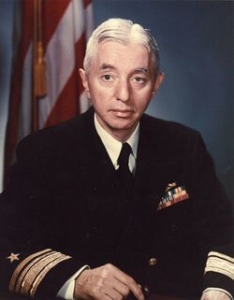
Adm. Hyman Rickover
History tells us that there were indeed individuals who lived long enough to
change the world and Admiral Hyman Rickover was certainly one of
them. However, today I doubt fewer than one in a thousand Americans
would know anything about him. Soon after the end of the Second World
War, he was considered one of the foremost experts in both mechanical
and electrical engineering and was one of the first to suggest the use of
atomic energy instead of fossil fuel to generate propulsion on naval ships. In 1946,
there was nobody that had any idea of how to do that and many
thought it a fool’s errand to put the deadly nuclear reactor on a warship already
fraught with danger. So, the Navy gave the job of figuring out the feasibility of producing steam using nuclear power to “then” Captain Rickover.
However, not done with that, he next conceptualized a plan to
put such fledgling technology on a submarine. Until then a submarine’s
Achilles heel was having to surface to charge batteries, which meant they
had to run noisy diesel engines that required a lot of oxygen. A submarine
running its engines on the surface just loses all of its stealth and thus
makes them vulnerable. Nuclear power would eliminate the need to go
anywhere near the surface and give submarines untold advantage over
any surface ship. In a little more than five years Admiral Rickover made
the concept of nuclear power on a submarine a very safe reality when
the USS Nautilus went to sea in 1952.
The Navy had originated the “Men in Black” (MIB’s) long before the
Hollywood movie came out. The Navy’s version was in the bureau of
Naval Reactors (NR) established by Admiral Rickover in 1949. In a general
sense, they dressed the same and were without personalities or humor. They
were like NASA engineers long before there was a space program. The
captain of a nuclear-powered submarine’s highest priority is the safe
operation of his reactor plant, it is paramount, and all other concerns of
his command are dwarfed by it. Any single incident exposing reactor
safety is reported immediately to the ships squadron commander. If he
suspects issues, he could report this to NR which might result in a visit
which in turn be extremely bad for the ship. NR is an entity vaguely like
the IRS, if they come knocking it’s a guarantee that you are about to have
the worst day in your life. We should all respect them; their mission is to
prevent naval reactor accidents, and as of now there has never been one.
Hymen Rickover started out as a plebe at the Naval Academy during
President Woodrow Wilson’s administration. By 1981, he was now a -four
star admiral and the only director that NR ever had.
For over 30 years, Rickover was one of the most powerful men in the department of defense. He ran the bureau of Naval Reactors with complete unhindered authority. Because he had ultimate power over anything that was
nuclear in the Navy and having cultivated powerful friends in congress, he
was allowed to remain on active duty long past the normal
retirement age. He had built himself a kingdom of sorts that most his
peers avoided at all costs. In other words, if you were in the world of
naval nuclear power, he was God.
Rickover had relationship issues with everyone during his
career. He despised most of his fellow admirals, the school he was a
graduate of, and some politicians who often grilled him over his policies.
Anyone who got in his way was to expect his temper as well as his wrath.
He and the MIB’s had designed the reactor plant as well as the entire
engineering space on the 688-class submarine. This infuriated a lot of
powerful folks over at the office of the Supervisor of Shipbuilding or SUPSHIP, who
now only had cognizance over the design of the forward part of the
submarine. Rickover had the personality of a rattlesnake and fought with
every Chief of Naval Operations that came and went for 36 years. In early
1961 he relocated his command from the Washington Naval Shipyard to
rented spaces in Crystal City Virginia, just to get away from Naval
Bureaucracy.
The men who he hired, these “Men in Black,” had wonderful
minds that could perform calculus in their heads and they could quote
verbatim any section of the manuals that they wrote which directed how
the reactor plant was to be operated. Rickover had groomed his disciples
and, like him, they were resolute in ensuring nuclear power safety and
perfection.
In the build-up to alpha trials the word was put out that Rickover and
his boys were going with us so they could see firsthand how safely the
reactor was being operated. Up to this point I had never heard of the
bureau of Naval Reactors and how important they were. At quarters one
day the non-engineering members of the ship’s company were reminded
that if at any time NR were around, we were to avoid having any contact
with them, always referring them to the duty officer. We were warned
that they would come onboard unexpectedly at any time to inspect the
engineering spaces, always looking for discrepancies. Anyways, I was
sure I would have nothing to do with them and that the command was
doing everything to elevate the stress level that was already barely
tolerable.
About a month before the alpha trials, the crew moved onboard the ship
and started standing normal in port watches. The pace doubled as we
practiced every evolution that a submarine needed proficiency in, no
matter how basic it was. Being a junior member of the duty section, I
started standing topside watch, ensuring only authorized personnel
were allowed access to the ship; that watch stood near the brow and
close to the forward escape trunk hatch, just aft of the sail, which was
the main access to and from the ship. Then, one very chilly night, around
three bells, I was topside waiting to be relieved after a four-hour watch.
The shipyard was deserted, and all yard birds had long gone home, when I
noticed two spooky dudes walking down the wharf heading my way. As
they got closer, I was quite sure who they were and called the below
decks watch and asked him to wake the duty officer and report “they’re
here.” I kept the phone to my ear trying to look busy as they started up
the brow. My plan was to delay them until an officer came topside. I was
flummoxed by what to do next: let the Bureau onboard or make them
wait for the duty officer. Standing in front of me now there was no doubt
who they were, and I now had eyes on these “Men in Black.” Mr. Smith
and Jones presented their identification to me and, as I fumbled through the various pages, I took longer than usual to locate the access list, mumbling incoherently all the while. I was flummoxed by what to do next, let the Bureau onboard or make them wait during a soft rain. Finally with their patience with me gone, I realized I could delay them no longer, so I cheerfully welcomed them on board without any similar retort.
Curiously, they proceeded down the engine room hatch which is not the
normal entrance point on any submarine. A few minutes later the duty
officer finally made it topside looking very agitated and all I had to do
was point aft and off he went trying desperately to get in front of the
“Bureau” and prevent potential damage control. All the stories I had
heard about them now seemed true, they were creepy, and their
presence normally affected rational submariners in strange ways.
During the weeks that followed and before the initial reactor plant
startup the Bureau was all over the engineering spaces sniffing out any
discrepancies that were occurring or about to happen and then correcting them
accordingly. Any violation of reactor plant safety during startup would
require a complete shutdown and cause a serious delay in the schedule.
If this happened, it would have significant consequences for the ship.
Likely it would mean a two-week delay in alpha trials while the ships
engineering department went through remedial training, more drills,
lectures, and procedural walk throughs. Thankfully, our ‘nukes” did an
excellent job in starting the plant up with zero glitches and Rickover gave
the San Francisco his blessing to proceed with alpha trials.
Then 10 February 1981 came and at 0800 all departments had
reported ready to get under way for the very first time. Already, in total
there were an additional forty riders from the shipyard and squadron
stuffed onboard, loitering everywhere; Rickover’s “team” of six would
make 160 souls onboard a submarine designed for 120. We had no
weapons onboard, so the torpedo room became a makeshift berthing
compartment with portable racks lined up neatly, athwartship. I had no
idea why they even bothered with this because nobody was going to get
the chance to use them. Of course, we were late getting underway, standing
by smartly, waiting for our celebrity rider and his inner circle to arrive.
Once onboard they were all shuffled down to the wardroom, and we
singled up all lines. We were finally underway on nuclear power,
followed ominously by a rescue ship.
Mister Keef had the hardest job of all during alpha trials, not only was
he the ships XO, but he was also the trials director as well as being
Rickover’s personal bodyguard. As trials director he would coordinate
every test that the ship would conduct that was directed by a rather
lengthy list of events that were to be performed in the next 24 hours.
Keef was constantly heard over the ships 1MC announcing system
coordinating events in no particular order, some events were all hands,
but others were local and required only select individuals. Event 01 might
be open then close torpedo tubes on the surface or raise and lower the
periscopes at 150 feet, all these events were recorded properly with
discrepancies noted. The crew had practiced for several days where
they had to be for each event. My assignment was simple enough and
required me to be in various places, manning a sound-powered circuit JA phone reporting the status of each event when directed.
A major concern to the command and entrusted to the executive
officer was ensuring that Rickover was always separated from the crew.
Rickover had ousted the XO from his state room (adjacent to the COs)
for his personal use for the cruise, which was normal for alpha trials.
It had been reported from past sea trials that he liked to mosey around
unscripted, and unescorted, looking for some very unlucky member of
the crew. If he found a victim, he would next rattle him by asking
improbable questions and then tripping off the line when he did not get the
answer he wanted. Young sailors are always a challenge to control, they
can be an unpredictable source of sarcasm when faced with unknown
etiquette. The ship posted a young member of the culinary division
outside the XOs stateroom, when he was in it hoping to prevent such
incursions. The XO was fully aware of this, and shadowed Rickover were
ever he went, always making sure he arrived wherever he wanted to go
without issues.
Alpha trials was a short cruise to quickly evaluate the ships’ ability
to operate submerged, run as much of the ships’ major equipment at
maximum loads. It then ends with an attempt to break the ships’ drive
train by running at a flank bell while stressing the propulsion system to
its design limit. I say break because at this point the Navy did not own
this ship, and the builder still had contractual obligation to fix all
discrepancies that were discovered. God had a dim view of ship builders
cultivated over 30 years of disputes over quality of their building
practices. The thought process was that if the ship was going to break
down it was better if it happened on alpha trials close to home with a
rescue ship standing by. If propulsion was lost due to malfunction this
would result in a very embarrassing tow back to the shipyard where the
builder would incur all costs of repair and not the taxpayers.
In reality fast attack submarines very rarely operate at a flank bell.
Every submarine that accelerates to a flank bell just significantly
increased their sound output, often needlessly, thus compromising its
warfare advantage and contradicting its mantra of the “Silent Service.”
Going flank requires additional maintenance during the next upkeep that
would not be necessary if the ship kept it at or below a full bell. However,
the Navy needed to know that this submarine could, if the time came,
achieve its maximum designed speed.
Alpha trials started immediately after getting underway. Some events
did not require all hands involvement and if you were lucky, you might
be able to relax somewhere out of sight. Soon we arrived at our assigned
operations area about fifty miles east of Norfolk and submerged for the
first time to periscope depth, and the fun was just getting started. I was
correct in assuming that I would be on my feet the entire time we were
underway. So, coming from the mess decks, as always there was the usual
cynicism with the catch phrase, “Don’t worry. If we make it back, you can
sleep then.” And so, the next 24 hours went by hectically. You either
participated in an event or were getting ready for the next one. If that
was not fun enough, because of all the extra riders onboard, there were
always long lines waiting to eat, to use the head or just standing in the
way as you tried to get from one space to the other.
I was soon back on watch in the control room enjoying a peaceful
break in the action. It was now four o’clock in the morning and 20 hours
into the trial. There was a quiet lull in the control room, too good to be
true. Next the crew was told to take station for the main event that some
were calling “showtime.” It was time for the infamous “crash back.” After
going to periscope depth and releasing a “situation report’ and
conducting a comms check with our escort, the order was given to
proceed to 500 feet and all ahead full. In the meantime, Admiral Rickover
had started to head aft chaperoned as always by the XO. Going aft from
the wardroom required passing through the mess decks where normally
there will be a gaggle of mess cooks cleaning the deck and supervised by
a large cook in the passageway blocking traffic. This is the reason that
the XO spearheads the way by making sure that everyone was out of
sight before Rickover and his posse passes by.
Everyone up forward felt the two main coolant pumps being placed in
high-speed mode that is necessary in achieving flank speed. Once settled
in the maneuvering space, standing directly behind the ships enlisted
throttleman, Rickover would order up a flank bell. It takes about thirty
seconds to go from ahead full (25 knots) to ahead flank (34 knots). In the
control room all eyes were on the inertial navigation system digital
readout, of speed over ground. We were all hoping that because we
were the first of Flight 2s that the modification in the engine room
would result in a speed record. I was not there, but I’m sure that everyone in
the engine room was bracing themselves, waiting for the speed report
that was soon to come from the control room. I was on one side of the
control room and the techs monitoring speed on the other; next came
loud congratulations and shouting when the ship reached and sustained
36 knots, a full two knots faster than all other ships in the same class.
This occurrence was reported by the CO to the entire crew by using the
1MC, the shipboard public address system. Next came the order for all back two thirds; a rarity that only happens during alpha trials. It is strange to say not really knowing, but I am sure God was expecting an engineering casualty to happen to his
beloved propulsion plant just so he could say “I told ya so!” His
constant accusations of inferior workmanship would then be justified.
What happened next is a once in a lifetime experience for most of us.
What was occurring was the equivalent of jamming an automobile into
reverse at 70 miles an hour. The absolutely astounding power of the
reactor plant was now in full display. A submarine going at a flank bell is
a sublime experience that is impossible to forget. Only at a flank bell will
you feel as well as hear the power of the propeller, pushing millions of
tons of sea water out of the way. The noise caused by the rushing of the
sea across the hull is quite distinct, as is feeling the gentle sway that is called yaw instability. This circular motion that only happens during a flank bell is unforgettable.
When all back two-thirds is ordered, the ship starts to quickly slow down
all the while shaking violently as the propeller works against the flow of
the sea. If the ships drive train was going to crap itself, it was now.
Then suddenly forward progress comes to zero and the ship starts moving
backwards. The Los Angelas class was not designed to go backwards,
back two-thirds’ was intended only to slow the ship down or back out of
a pier. Depth control is impossible when moving astern at six knots, a
submarine cannot go backwards for long, and danger awaits those who
try. Then when he has seen enough, Rickover mercifully orders “All stop!”
and the crash back as the last event was over. For those of us
crammed in together tightly in the control room we could breathe again.
The engine room did not break off and sink to the bottom. There were no casualties,
no alarms, just a combined sense of relief, a hushed silence that seemed
longer than it was. Alpha trial was history. We had a propulsion system
that worked properly. Next came surfacing and a transit home.
The sun was about 30 minutes away from rising and the ship was on
the surface heading due west to Newport News. At night on the surface
a submarine usually has the Officer of the Deck stationed on the bridge
(on top of the conning tower) and the control room rigged for black or
all lighting off. I was still on watch with three hours left before making
port.
There were way too many crew members bounding about
performing there assigned duties coming and going and it was hard to make
out their faces due to the darkness. I was standing mostly out of the way
on the back starboard side of the control room standing next to a chart
table keeping my log up and trying to stay awake. I’m afraid to say this,
but I found a way to stay upright by wedging snuggly my left arm through
a cable run and a stanchion, sometimes cat napping all the while
remaining unnoticed in the darkness. Up till now I had not laid eyes on
Admiral Rickover like some of my shipmates who got a very brief
glance at him walking through the mess decks. I heard while entering the
wardroom Rickover went berserk on a friend of mine who was in the
wardroom cleaning up and thus demonstrating his well-known temper;
I thoughtlessly was glad that it was not me. Next and very suddenly
without any warning, the forward door leading in and out of the control
room opened and at the same time all the fluorescent overhead lights
came on, bringing shouts and groans from all that were present. Making
a blunder by turning white lights on when rigged for red is usually a big
no-no but today was not a normal day. It was as if a sunrise service were
about to start, and heaven had opened up. All eyes were now straining to
adjust to the lights and we were wondering if we were about to witness
something divine. It became clear that our XO was the cause of the
sudden illumination as he barged in pushing watch standers out of his
way.
My blurry eyes now told me that he was coming in my direction as I instinctively pulled my left arm free. But then a mysterious shape moved away from behind Keef and became annoyed waiting for our
stunned Senior Chief Fire controlman to vacate a bench locker so he
could sit down. Of course, this had to be God, and my first impression
was that he really was smaller than everyone had said. He was wearing
a set of starched khakis that was too big and without any epaulets that
displayed his rank, he looked like a rattlesnake about to bite.
Immediately there was complete silence in the control room as everyone
became aware of his presence as well as wondering what the hell was
going on. It soon became evident that God was about to hold court for
some reason, and he wanted to do it dangerously close to where I was
standing. I tried to give him some space by backing away, but at the same
time more riders started packing into the control room from the aft door
and now I had someone pushing me forward and peering over my
shoulder, vying for a spot to witness what was soon to come. Once all of
his disciples had taken station, God’s presence was now revealed and
that he soon would speak to us, a bible quote perhaps, or a sermon, seeing that
it was indeed Sunday.
The Captain had the honor to present Rickover to the crew over the ships 1MC, his introduction was brief, but then came a long, rambling unscripted speech that was difficult for me at the time to comprehend.
I was almost sitting in his lap when he started to talk, he
had no notes and had to use both hands to steady the microphone that
was presented to him. It was an unforgettable moment for me; I was
staring at God. Keef was staring at me and Rickover was staring out at his
legacy, maybe he could see where our country was going, perhaps a
warning to us that he describes so hauntingly at the end of his speech,
about an America that he would likely never live to see.
The XO was thinking the worst of me because up till now no
crewmember that I knew of had been allowed to be in such close
proximity to Rickover and for that long of a time, I was close enough to
touch him. My boss must have been thinking that I had it in me to wreck
the sea trial by punking a 4-star admiral. This would have caused an
uproar that would have brought tears of amusement at the Pentagon,
but would not have gone well for me. I now understand his concern because in the days that followed, I received several suggestions coming from the mess decks
as usual, on what I should have done. Any one of these would have put
me into the Infamous Hall of fame and now will be better if left
unmentioned. Keef was staring at me and with his eyes he was saying
“Don’t do it, and if you do it you will pay!” The man did not know that I
did not have it in me to be so low and soon the “sermon from a bench”
was over without interruption from anyone.
As Rickover got up to leave, he glanced for a split second at me and then headed out the door from which he had entered. So, there I was, frozen in the moment, trying to recount and understand what he was talking about. Luckily, his speech was recorded and later made available. After reading it repeatedly, I now know what he meant. It is a timeless meaning, so relevant in the America of today:
“We have just completed alpha trials on the San Francisco and the
propulsion plant operated satisfactory. I want to once again congratulate
the engineers and craftsman of the Newport News Shipbuilding and
drydock company for their excellent work as evidenced by this successful
trial. The men and women of Newport News continue the tradition of
shipbuilding competence that the Navy counts on. I especially want to
congratulate the officers and men of the USS San Francisco. Anyone
witnessing these trials would find it hard to believe that over half of the
crew had never been to sea before except for short training periods. The
men and officers have demonstrated they are capable of doing an
outstanding job. I know that you will continue to do your duties in the
same outstanding manner. Our country should be proud of Commander Marshall, the officers, and his men. On behalf of the Navy, I thank all of you for a job well done.
Since no church service could be held on board the San Francisco this
Sunday, I am taking advantage of the occasion to deliver a little homily. I
was born in the first year of this century and experienced a childhood
which had not changed much since that of the time of the Civil War. I now
live in the age of nuclear weapons, space travel, and silicon chips. These
diverse experiences make me feel as though I have been a participant in
two separate lives. But I am much the same person I was in the early days.
There were no automobiles on the road; horses were still man’s most
important companion and friend from the animal world. At night with no
electricity there was total darkness, only lit by the moon and stars. Except
for the barking of a dog or the hoofbeats of a horse, it was quiet.
In the present age there is no unifying faith to bind us together; in its
place there is only half-hearted adherence to many conflicting and
diverse forms of ideological or emotional nonsense.
Another attribute for the vanished age which distinguished it from that
of the was the reliance on reason; on the cumulative knowledge of the
past; of common sense, instead of pop, fashion, or craze. Despite the vast improvement in living and social conditions and great technological and scientific advances that I have witnessed in my lifetime, there is one thing that I should like to be reborn which is missing in the materially guided United States of today. This is the belief in the importance of honorable conduct and dealings’ confidence in men and
women of all classes and callings in their own capacity for reasons of
good sense, and a pride in our country and its achievement, past present
and future.
This was shared by aristocrat, bourgeois and working man alike. These,
despite all the differences in individual circumstances and ways of life,
made us united as one nation. And these ideals which cannot be served
by money alone are what make people great. And what our people are
is what our country is.”
Then it was all over, and alpha trial was complete. The San Francisco
was back tied up at the shipyard and Admiral Rickover was gone as well
as the Men in Black. Next up for us was Bravo trials or sound trials, where
technicians got to listen to how much noise the ship made at various
speeds. They later reported back that the ship with the new Flight 2 silencing
improvements was now the quietest submarine in the fleet. On the 24
of April 1981 the San Francisco was commissioned at Pier 4 Naval Base
Norfolk attended by none other than the Secretary of Defense Casper
Weinberger who told about 2,000 dignitaries in attendance that my
ship was now the fastest, quietist and most deadly submarine in the
world. We proudly left Norfolk for good in June 1981 and headed for the
Panama Canal. Once in the Pacific Ocean we turned north to our
namesake city and participated in Fleet Week, a City of San Francisco
tradition. It was a four-day party where Mayor Feinstein presented us the
ceremonial key to the city. Once the party was over, my ship sailed west
to Pearl Harbor and had a long-storied career.
I transferred from the San Francisco two years later to continue my
journey elsewhere. About eight years later while stationed in Holy Loch
Scotland, I was tracked down by the Navy’s Bureau of Medicine because
of their concern about my time working on shore. I was directed by the
Submarine Squadron 14 doctor to get an X-ray and take various lung
function tests for mesothelioma. It turned out that all that nasty dust
back in “Building 1” might have been spiked with deadly asbestos.
Thankfully, my test was negative, however, years later through the
wonder of social media I found out that several of my shipmates had
developed serious lung issues that were related to the time in the
shipyard.
As for Admiral Rickover he went back to Crystal City but not for long.
He participated in one more alpha trial on the USS La Jolla that did not
go as anticipated. During the infamous crash-back the Admiral froze and
his inaction by not ordering “all stop” while backing at two-thirds caused
a horrific loss of ships depth due to a 40 degree aft leaning down bubble;
this caused a panic in the control room resulting in their captain ordering
an emergency main ballast tank blow to the surface, that likely saved his
ship.
Several days later, once back in Washington, Rickover was ordered
to the White House to answer for it in person to the President. On 31
January 1982, the then 83-year-old Admiral was told while sitting in the
Oval Office that his service to the Navy was no longer desired and he was
now retired. It took President Regan to break the news to Rickover in
person, and after 67 years in the Navy he was unceremoniously let out to
pasture.
Now, at this point the astute reader might say that I never really met
Admiral Rickover. Then, I would have to consider the word “meeting.”
Does meeting someone require a hardy handshake and a lengthy
conversation? If so, then I never did met God, but then no one met him
on that day. I would explain that at this point in Rickover’s earthly
existence “meeting” someone was not what God did. It was germane to
Rickover that by the time a ship started builders’ trials everyone on it was
competent, superbly trained and had the complete confidence of the
local commanders to proceed to sea and then safely operate the ship.
Rickover was not there to get to know anyone, let alone a simple control
room watch stander that for a moment had a chance encounter with
him. So, without any preconceived meaning of the word “meet” I still say
that I met God.
I now live in the DC area and a frequent visitor to Arlington National
Cemetery, and every time I’m there I always stroll past where Rickover is
buried. Near president Kennedy’s grave and under a Japanese cheery tree
you will find where the Admiral is buried. As always, I stop there for a
moment and remember that time so long ago that I, a mere mortal, had
the fortune to stand, for just for a moment, next to God.


